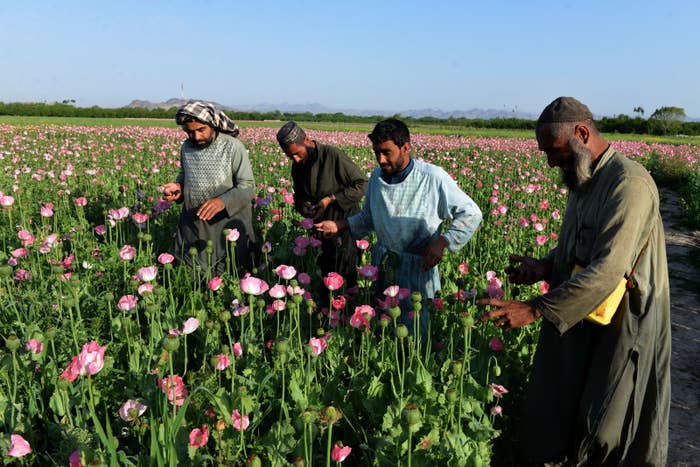
The US and Afghan air forces have begun bombing the Taliban’s drug-producing facilities as part of the Trump administration’s new strategy for the 16-year conflict, officials from both countries said on Monday.
A series of strikes on Sunday destroyed 10 opium processing labs in Helmand province, according to the Pentagon and the Afghan government. The Taliban control much of the territory where the poppy is cultivated, and the drug money fuels their fight against the Afghan government and its allies.
“In striking northern Helmand and the drug enterprises there, we're hitting the Taliban where it hurts, which is their finances,” US Army Gen. John Nicholson, speaking from Kabul, told reporters at the Pentagon on Monday. “The new authorities allow me to go after revenue streams of the enemy.”
Nicholson said the strikes are part of President Donald Trump’s new strategy in Afghanistan, which includes committing thousands more troops to the war. The authorities granted by Trump on Aug. 21 allow the military to attack the Taliban’s financial networks and revenue streams.
In a video shown to reporters at the Pentagon on Monday, the US Air Force used a B-52 bomber to strike a facility “with over 50 barrels of opium cooking at the time of the strike,” Nicholson said.
"Last night, we conducted strikes into Northern Helmand to hit the Taliban where it hurts: their narcotics financin… https://t.co/0GKMAsWatl
“The street value of this is in the millions of dollars,” he said. “So this was a B-52 strike, several 2,000-pound bombs, and it completely obliterated the facility.”
In another video, a F-22 Raptor, one of the US military’s most advanced fighter aircraft, demolished a complex with a 250-pound bomb. The strikes will continue into Monday, Nicholson said, stressing that farmers would not be targeted. There are an estimated 400 to 500 active drug labs in Afghanistan, the Pentagon said.
Afghan President Ashraf Ghani announced on Twitter that eight labs had been destroyed in one day.
“Last night, Afghan and U.S. forces launched operations in Helmand to abolish opium processing labs,” he said. “We're determined to tackle criminal economy and narcotics trafficking with full force. It's the main source of financing violence and terror.”
Despite the US spending an estimated $8.6 billion on counternarcotics efforts since the war began in October 2001, Afghanistan remains the world’s largest opium producer and exporter. It produces an estimated 80% of the world’s opium, according to SIGAR.
This year Afghanistan nearly doubled its opium production, according to a UN report released this month, going from 4,800 metric tons to 9,000 metric tons. Insurgents generate an estimated $200 million a year from poppy cultivation and opium production, according to the Pentagon.
The new targeting of drug labs comes as the security situation in Afghanistan continues to deteriorate and the Trump administration has committed 3,500 more troops, on top of the 11,000 already there to train and assist Afghan security forces.
Last night, Afghan and US forces launched operations in Helmand to abolish opium processing labs. 8 labs were destr… https://t.co/uBreTfE3Ow
As of August, 13% of Afghanistan’s 407 districts were under Taliban control or influence, according to a report by the Special Inspector General for Afghanistan Reconstruction, or SIGAR. That is up from 11% in February, the watchdog said, meaning that an additional 700,000 Afghans live under Taliban influence.
Even so, military officials on Monday insisted that 2017 had been a bad year for the Taliban because they “failed to meet any of their military objectives,” including taking over cities, suffering significant casualties and infighting within their leadership.
Nicholson also said he expects to see an impact from the Pentagon’s reallocation of resources to Afghanistan as “things have gone well in Iraq and Syria” in the fight against ISIS.
“We're beginning to see the effects of a shift of resources," he said, "which will increase over the course of the winter, going into the spring, as the situation continues to improve there.”
